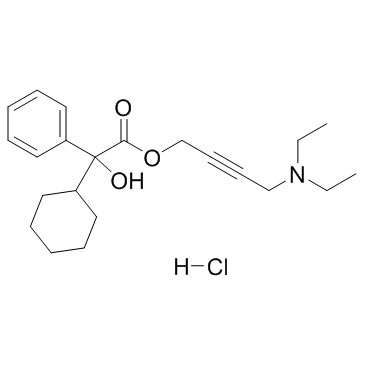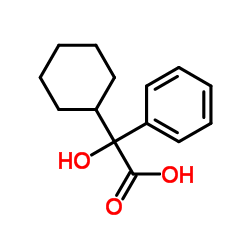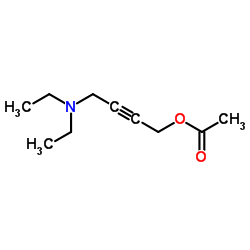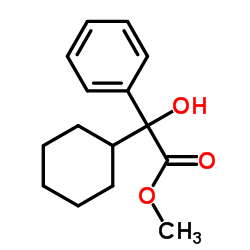oxybutynin

oxybutynin structure
|
Common Name | oxybutynin | ||
|---|---|---|---|---|
| CAS Number | 5633-20-5 | Molecular Weight | 357.486 | |
| Density | 1.1±0.1 g/cm3 | Boiling Point | 494.4±45.0 °C at 760 mmHg | |
| Molecular Formula | C22H31NO3 | Melting Point | 125 - 130ºC | |
| MSDS | N/A | Flash Point | 252.8±28.7 °C | |
Use of oxybutyninOxybutynin is an anticholinergic medication used to relieve urinary and bladder difficulties.Target: mAChROxybutynin is an anticholinergic medication used to relieve urinary and bladder difficulties, including frequent urination and inability to control urination (urge incontinence), by decreasing muscle spasms of the bladder. Oxybutynin competitively antagonizes the M1, M2, and M3 subtypes of the muscarinic acetylcholine receptor. It also has direct spasmolytic effects on bladder smooth muscle as a calcium antagonist and local anesthetic, but at concentrations far above those used clinically. Oxybutynin is available orally in generic formulation or as the brand-names Ditropan, Lyrinel XL, or Ditrospam, as a transdermal patch under the brand name Oxytrol, and as a topical gel under the brand name Gelnique. Oxybutynin is also a possible treatment of hyperhidrosis (hyper-active sweating) [1-3]. |
| Name | oxybutynin |
|---|---|
| Synonym | More Synonyms |
| Description | Oxybutynin is an anticholinergic medication used to relieve urinary and bladder difficulties.Target: mAChROxybutynin is an anticholinergic medication used to relieve urinary and bladder difficulties, including frequent urination and inability to control urination (urge incontinence), by decreasing muscle spasms of the bladder. Oxybutynin competitively antagonizes the M1, M2, and M3 subtypes of the muscarinic acetylcholine receptor. It also has direct spasmolytic effects on bladder smooth muscle as a calcium antagonist and local anesthetic, but at concentrations far above those used clinically. Oxybutynin is available orally in generic formulation or as the brand-names Ditropan, Lyrinel XL, or Ditrospam, as a transdermal patch under the brand name Oxytrol, and as a topical gel under the brand name Gelnique. Oxybutynin is also a possible treatment of hyperhidrosis (hyper-active sweating) [1-3]. |
|---|---|
| Related Catalog | |
| References |
| Density | 1.1±0.1 g/cm3 |
|---|---|
| Boiling Point | 494.4±45.0 °C at 760 mmHg |
| Melting Point | 125 - 130ºC |
| Molecular Formula | C22H31NO3 |
| Molecular Weight | 357.486 |
| Flash Point | 252.8±28.7 °C |
| Exact Mass | 357.230408 |
| PSA | 49.77000 |
| LogP | 5.19 |
| Vapour Pressure | 0.0±1.3 mmHg at 25°C |
| Index of Refraction | 1.546 |
| InChIKey | XIQVNETUBQGFHX-UHFFFAOYSA-N |
| SMILES | CCN(CC)CC#CCOC(=O)C(O)(c1ccccc1)C1CCCCC1 |
| Storage condition | -20°C |
|
Material Safety Data Sheet
Section1. Identification of the substance Product Name: Oxybutynin Synonyms: Section2. Hazards identification Harmful by inhalation, in contact with skin, and if swallowed. Section3. Composition/information on ingredients. Ingredient name:Oxybutynin CAS number:5633-20-5 Section4. First aid measures Skin contact:Immediately wash skin with copious amounts of water for at least 15 minutes while removing contaminated clothing and shoes. If irritation persists, seek medical attention. Eye contact:Immediately wash skin with copious amounts of water for at least 15 minutes. Assure adequate flushing of the eyes by separating the eyelids with fingers. If irritation persists, seek medical attention. Inhalation:Remove to fresh air. In severe cases or if symptoms persist, seek medical attention. Ingestion:Wash out mouth with copious amounts of water for at least 15 minutes. Seek medical attention. Section5. Fire fighting measures In the event of a fire involving this material, alone or in combination with other materials, use dry powder or carbon dioxide extinguishers. Protective clothing and self-contained breathing apparatus should be worn. Section6. Accidental release measures Personal precautions: Wear suitable personal protective equipment which performs satisfactorily and meets local/state/national standards. Respiratory precaution:Wear approved mask/respirator Hand precaution:Wear suitable gloves/gauntlets Skin protection:Wear suitable protective clothing Eye protection:Wear suitable eye protection Methods for cleaning up: Mix with sand or similar inert absorbent material, sweep up and keep in a tightly closed container for disposal. See section 12. Environmental precautions: Do not allow material to enter drains or water courses. Section7. Handling and storage Handling:This product should be handled only by, or under the close supervision of, those properly qualified in the handling and use of potentially hazardous chemicals, who should take into account the fire, health and chemical hazard data given on this sheet. Store in closed vessels, refrigerated. Storage: Section8. Exposure Controls / Personal protection Engineering Controls: Use only in a chemical fume hood. Personal protective equipment: Wear laboratory clothing, chemical-resistant gloves and safety goggles. General hydiene measures: Wash thoroughly after handling. Wash contaminated clothing before reuse. Section9. Physical and chemical properties Appearance:Not specified Boiling point:No data No data Melting point: Flash point:No data Density:No data Molecular formula:C22H31NO3 Molecular weight:357.5 Section10. Stability and reactivity Conditions to avoid: Heat, flames and sparks. Materials to avoid: Oxidizing agents. Possible hazardous combustion products: Carbon monoxide, nitrogen oxides. Section11. Toxicological information No data. Section12. Ecological information No data. Section13. Disposal consideration Arrange disposal as special waste, by licensed disposal company, in consultation with local waste disposal authority, in accordance with national and regional regulations. Section14. Transportation information Non-harzardous for air and ground transportation. Section15. Regulatory information No chemicals in this material are subject to the reporting requirements of SARA Title III, Section 302, or have known CAS numbers that exceed the threshold reporting levels established by SARA Title III, Section 313. SECTION 16 - ADDITIONAL INFORMATION N/A |
| HS Code | 2922509090 |
|---|
|
~% 
oxybutynin CAS#:5633-20-5 |
| Literature: WO2009/122429 A2, ; Page/Page column 7 ; |
|
~% 
oxybutynin CAS#:5633-20-5 |
| Literature: US2009/247628 A1, ; Page/Page column 53-54 ; US 20090247628 A1 |
|
~% 
oxybutynin CAS#:5633-20-5 |
| Literature: WO2009/122429 A2, ; Page/Page column 6-7 ; |
| HS Code | 2922509090 |
|---|---|
| Summary | 2922509090. other amino-alcohol-phenols, amino-acid-phenols and other amino-compounds with oxygen function. VAT:17.0%. Tax rebate rate:13.0%. . MFN tariff:6.5%. General tariff:30.0% |
| cyclohexyl(hydroxy)phénylacétate de 4-(diéthylamino)but-2-yn-1-yle |
| Cystrin |
| Oxybutyninum |
| EINECS 202-516-5 |
| 4-(Diethylamino)but-2-yn-1-yl cyclohexyl(hydroxy)phenylacetate |
| Oxybutynine |
| benzeneacetic acid, a-cyclohexyl-a-hydroxy-, 4-(diethylamino)-2-butyn-1-yl ester |
| a-Phenylcyclohexaneglycolic acid 4-(diethylamino)-2-butynyl ester |
| a-Cyclohexyl-a-hydroxybenzene acetic acid 4-(diethylamino)-2-butynyl ester |
| Benzeneacetic acid, α-cyclohexyl-α-hydroxy-, 4-(diethylamino)-2-butyn-1-yl ester |
| Oxybutynin Base |
| 4-(Diethylamino)but-2-in-1-ylcyclohexyl(hydroxy)phenylacetat |
| 4-Diethylamino-2-butynyl phenyl cyclohexylglycolate |
| MFCD00865252 |
| Oxybutinin |
| Lyrinel XL |
| 4-(Diethylamino)-2-butyn-1-yl cyclohexyl(hydroxy)phenylacetate |
| Pollakisu |
| 4-(diethylamino)but-2-ynyl 2-cyclohexyl-2-hydroxy-2-phenylacetate |
| Oxytrol |
| Oxybutynin |
| Ditropan |
| Oxibutinina |
| Oxibutyninum |




